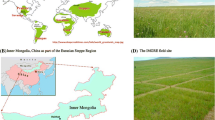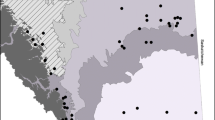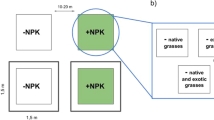Abstract
Species-rich native grasslands are frequently converted to species-poor exotic grasslands or pastures; however, the consequences of these changes for ecosystem functioning remain unclear. Cattle grazing (ungrazed or intensely grazed once), plant species origin (native or exotic), and species richness (4-species mixture or monoculture) treatments were fully crossed and randomly assigned to plots of grassland plants. We tested whether (1) native and exotic plots exhibited different responses to grazing for six ecosystem functions (i.e., aboveground productivity, light interception, fine root biomass, tracer nitrogen uptake, biomass consumption, and aboveground biomass recovery), and (2) biodiversity–ecosystem functioning relationships depended on grazing or species origin. We found that native and exotic species exhibited different responses to grazing for three of the ecosystem functions we considered. Intense grazing decreased fine root biomass by 53% in exotic plots, but had no effect on fine root biomass in native plots. The proportion of standing biomass consumed by cattle was 16% less in exotic than in native grazed plots. Aboveground biomass recovery was 30% less in native than in exotic plots. Intense grazing decreased aboveground productivity by 25%, light interception by 14%, and tracer nitrogen uptake by 54%, and these effects were similar in native and exotic plots. Increasing species richness from one to four species increased aboveground productivity by 42%, and light interception by 44%, in both ungrazed and intensely grazed native plots. In contrast, increasing species richness did not influence biomass production or resource uptake in ungrazed or intensely grazed exotic plots. These results suggest that converting native grasslands to exotic grasslands or pastures changes ecosystem structure and processes, and the relationship between biodiversity and ecosystem functioning.



Similar content being viewed by others
References
Asner GP, Elmore AJ, Olander LP, Martin RE, Harris AT (2004) Grazing systems, ecosystem responses, and global change. Annu Rev Environ Resour 29:261–299
Balvanera P et al (2006) Quantifying the evidence for biodiversity effects on ecosystem functioning and services. Ecol Lett 9:1146–1156
Best RJ, Arcese P (2009) Exotic herbivores directly facilitate the exotic grasses they graze: mechanisms for an unexpected positive feedback between invaders. Oecologia 159:139–150
Buchmann N, Gebauer G, Schulze ED (1996) Partitioning of 15N-labeled ammonium and nitrate among soil, litter, below- and above-ground biomass of trees and understory in a 15-year-old Picea abies plantation. Biogeochemistry 33:1–23
Byrnes J, Stachowicz JJ (2009) Short and long term consequences of increases in exotic species richness on water filtration by marine invertebrates. Ecol Lett 12:830–841
Cardinale BJ et al (2006) Effects of biodiversity on the functioning of trophic groups and ecosystems. Nature 443:989–992
Chaneton EJ, Perelman SB, Omacini M, Leon RJC (2002) Grazing, environmental heterogeneity, and alien plant invasions in temperate Pampa grasslands. Biol Invasions 4:7–24
Coley PD, Bryant JP, Chapin FS (1985) Resource availability and plant antiherbivore defense. Science 230:895–899
D’Antonio CM, Vitousek PM (1992) Biological invasions by exotic grasses, the grass fire cycle, and global change. Annu Rev Ecol Syst 23:63–87
Daehler CC (2003) Performance comparisons of co-occurring native and alien invasive plants: implications for conservation and restoration. Annu Rev Ecol Evol Syst 34:183–211
Dybzinski R, Tilman D (2007) Resource use patterns predict long-term outcomes of plant competition for nutrients and light. Am Nat 170:305–318
Fry B (2006) Stable isotope ecology. Springer, New York
Hautier Y, Niklaus PA, Hector A (2009) Competition for light causes plant biodiversity loss after eutrophication. Science 324:636–638
Hector A, Hooper R (2002) Darwin and the first ecological experiment. Science 295:639–640
Hobbs RJ et al (2006) Novel ecosystems: theoretical and management aspects of the new ecological world order. Glob Ecol Biogeogr 15:1–7
Hooper DU et al (2005) Effects of biodiversity on ecosystem functioning: a consensus of current knowledge. Ecol Monogr 75:3–35
Isbell FI (2010) Processes that influence biodiversity, ecosystem functioning, and stability in grasslands. PhD dissertation, Iowa State University, Ames
Isbell FI, Polley HW, Wilsey BJ (2009) Species interaction mechanisms maintain grassland plant diversity. Ecology 90:1821–1830
Keeley JE, Lubin D, Fotheringham CJ (2003) Fire and grazing impacts on plant diversity and alien plant invasions in the southern Sierra Nevada. Ecol Appl 13:1355–1374
Kimball S, Schiffman PM (2003) Differing effects of cattle grazing on native and alien plants. Conserv Biol 17:1681–1693
Levy EG, Madden EA (1933) The point method of pasture analysis. N Z J Agric 46:267–279
Liao CZ et al (2008) Altered ecosystem carbon and nitrogen cycles by plant invasion: a meta-analysis. New Phytol 177:706–714
Loreau M, Hector A (2001) Partitioning selection and complementarity in biodiversity experiments. Nature 412:72–76
Losure DA, Wilsey BJ, Moloney KA (2007) Evenness-invasibility relationships differ between two extinction scenarios in tallgrass prairie. Oikos 116:87–98
McNaughton SJ (1979) Grazing as an optimization process: grass-ungulate relationships in the Serengeti. Am Nat 113:691–703
McNaughton SJ (1985) Ecology of a grazing ecosystem: the Serengeti. Ecol Monogr 55:259–294
McNaughton SJ (1993a) Biodiversity and ecosystem function of grazing ecosystems. In: Schulze ED, Mooney HA (eds) Biodiversity and ecosystem function. Springer, Berlin, pp 361–383
McNaughton SJ (1993b) Grasses and grazers, science and management. Ecol Appl 3:17–20
McNaughton SJ, Oesterheld M, Frank DA, Williams KJ (1989) Ecosystem-level patterns of primary productivity and herbivory in terrestrial habitats. Nature 341:142–144
Milchunas DG, Lauenroth WK (1993) Quantitative effects of grazing on vegetation and soils over a global range of environments. Ecol Monogr 63:327–366
Minns A et al (2001) The functioning of European grassland ecosystems: potential benefits of biodiversity to agriculture. Outlook Agric 30:179–185
Painter EL, Belsky AJ (1993) Application of herbivore optimization theory to rangelands of the western United States. Ecol Appl 3:2–9
Peterson BJ, Fry B (1987) Stable isotopes in ecosystem studies. Annu Rev Ecol Syst 18:293–320
Picasso VD, Brummer EC, Liebman M, Dixon PM, Wilsey BJ (2008) Crop species diversity affects productivity and weed suppression in perennial polycultures under two management strategies. Crop Sci 48:331–342
Proulx M, Mazumder A (1998) Reversal of grazing impact on plant species richness in nutrient-poor vs. nutrient-rich ecosystems. Ecology 79:2581–2592
Reich PB et al (2001) Plant diversity enhances ecosystem responses to elevated CO2 and nitrogen deposition. Nature 410:809–812
Sanderson MA, Skinner RH, Barker DJ, Edwards GR, Tracy BF, Wedin DA (2004) Plant species diversity and management of temperate forage and grazing land ecosystems. Crop Sci 44:1132–1144
Schmid B, Hector A, Saha P, Loreau M (2008) Biodiversity effects and transgressive overyielding. J Plant Ecol 1:95–102
Seastedt TR, Hobbs RJ, Suding KN (2008) Management of novel ecosystems: are novel approaches required? Front Ecol Environ 6:547–553
Simoes M, Baruch Z (1991) Responses to simulated herbivory and water-stress in two tropical C4 grasses. Oecologia 88:173–180
Smith MD, Knapp AK (2001) Physiological and morphological traits of exotic, invasive exotic, and native plant species in tallgrass prairie. Int J Plant Sci 162:785–792
Vila M, Weiner J (2004) Are invasive plant species better competitors than native plant species? Evidence from pair-wise experiments. Oikos 105:229–238
Wassenaar T, Gerber P, Verburg PH, Rosales M, Ibrahim M, Steinfeld H (2007) Projecting land use changes in the Neotropics: the geography of pasture expansion into forest. Glob Environ Change Hum Policy Dimens 17:86–104
Weigelt A, Weisser WW, Buchmann N, Scherer-Lorenzen M (2009) Biodiversity for multifunctional grasslands: equal productivity in high-diversity low-input and low-diversity high-input systems. Biogeosciences 6:1695–1706
Wilsey BJ (2005) Importance of species replication in understanding plant invasions into North American grasslands. In: Inderjit S (ed) Invasive plants: ecological and agricultural aspects. Birkhauser, Switzerland
Wilsey BJ, Polley HW (2006) Aboveground productivity and root-shoot allocation differ between native and introduced grass species. Oecologia 150:300–309
Wilsey BJ, Coleman JS, McNaughton SJ (1997) Effects of elevated CO2 and defoliation on grasses: a comparative ecosystem approach. Ecol Appl 7:844–853
Wilsey BJ, Teaschner TB, Daneshgar PP, Isbell FI, Polley HW (2009) Biodiversity maintenance mechanisms differ between native and novel exotic-dominated communities. Ecol Lett 12:432–442
Worm B et al (2006) Impacts of biodiversity loss on ocean ecosystem services. Science 314:787–790
Acknowledgments
We thank Dan Isbell, Steve Goepferd, Leah Isbell, Kathryn Yurkonis, Joe Reynolds, Chris Johnson, Cedar Johnson, Kim Isbell, Joni Richmond, Robert Handler, Leanne Martin, Adam Heathcote, Wayne Roush, and Don Hummel for help with field work. This project was supported by a grant from the US National Science Foundation (DEB-0639417) to B.J.W. and a grant from the Leopold Center for Sustainable Agriculture to B.J.W. and F.I.I. We thank Jason Kaye and anonymous reviewers for helpful comments on an earlier version of this manuscript.
Author information
Authors and Affiliations
Corresponding author
Additional information
Communicated by Jason Kaye.
Rights and permissions
About this article
Cite this article
Isbell, F.I., Wilsey, B.J. Increasing native, but not exotic, biodiversity increases aboveground productivity in ungrazed and intensely grazed grasslands. Oecologia 165, 771–781 (2011). https://doi.org/10.1007/s00442-010-1877-9
Received:
Accepted:
Published:
Issue Date:
DOI: https://doi.org/10.1007/s00442-010-1877-9




